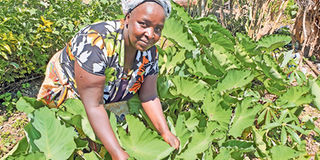Woman finds formula to reap big from tiny farm

Beatrice Wangui, checks on arrowroots that she grows in her farm in Gathigiriri village, some 15 kilometres from Gilgil Town. She says she learnt about the organic farming methods from grass roots farming groups known as Seed Savers Network, which is based in Gilgil. PHOTO | RACHEL KIBUI | NATION MEDIA GROUP
What you need to know:
- The technology involves digging a hole in which she puts some wood waste, then maize stalks, charcoal dust and manure, before planting arrowroot seedlings.
- Besides the section on her quarter acre farm on which she has planted arrowroots currently, she is preparing another measuring about two by four metres for the crop.
- Not far away is a healthy spinach crop, some grown in gunny bags, while others are planted in vertical, round mouldings.
- She has also recycled old tyres, which she buries partly into the soil, fills with a mixture of manure and soil and plants vegetables and coriander.
On Beatrice Wangui’s farm in Gathigiriri village, some 15 kilometres from Gilgil Town, you find various lush crops.
Those that stand out, however, are arrowroots, which she farms using a technology known as hugo culture.
The technology involves digging a hole in which she puts some wood waste, then maize stalks, charcoal dust and manure, before planting arrowroot seedlings.
“I get the off-cuts from construction sites. They are about one-to-two metres long. The first layer consists of the big ones, second the thinner ones, while third are twigs collected from nearby bushes,” she says.
“The technology helps the crops get maximum nutrients and also conserves water, especially because charcoal dust holds water for long,” she adds.
Since the soil is light, the holes where she plants arrowroot are about the size of her hand, as she was advised by experts.
She also makes big holes, about one metre wide, three metres long, with a depth of one metre, for bigger crops.
Besides the section on her quarter acre farm on which she has planted arrowroots currently, she is preparing another measuring about two by four metres for the crop.
A few metres from the arrowroots section are three huge plastic containers filled with soil and manure in which she is planning to plant coriander.
“I went to my neighbour whose tank was leaking and he was wondering how to dispose of it,” recalls Peter Mwangi, Beatrice’s husband. “I told him to give it to me. I then cut it into three and turned them into gardens.”
This, Mwangi says, was in support of his wife who is very passionate about organic farming.
Not far away is a healthy spinach crop, some grown in gunny bags, while others are planted in vertical, round mouldings.
RECYCLED POLYTHENE BAGS
Before planting in gunny bags, Beatrice filled them with a mixture of soil, manure and charcoal dust.
At the centre though, she fills the bags with ballast, as this helps in spreading water evenly throughout the farm thus ensuring that the water reaches out to the roots of each crop.
She has planted more vegetables in vertical gardens, which are made of recycled polythene bags.
“Although I am a professional tailor, I use the tailoring skill to make the gunny bags for my farm,” says Beatrice
She has also recycled old tyres, which she buries partly into the soil, fills with a mixture of manure and soil and plants vegetables and coriander.
“To control pests and diseases, I ensure there is minimal weed infestation on my farm,” she says. Additionally, she plants spring onion whose aroma, she says, repels pests such as white flies.
Beatrice says she learnt about the organic farming methods from grass roots farming groups known as Seed Savers Network, which is based in Gilgil.
According to experts, farmers who own small farms can work together and produce intensively for domestic consumption as well as for sale.
Ronnie Vernooy, a Genetic Resource Policy Specialist at Bioversity International, says such farmers can work in groups, specialise in producing particular crops and target specific markets.
“Farmers can for example decide to produce organic herbs, set prices and look for a suitable market they can sustainably supply,” says Vernooy
He describes Beatrice’s farm as a classic example of how one can properly use space, labour, knowledge and resources such as soil and water.





